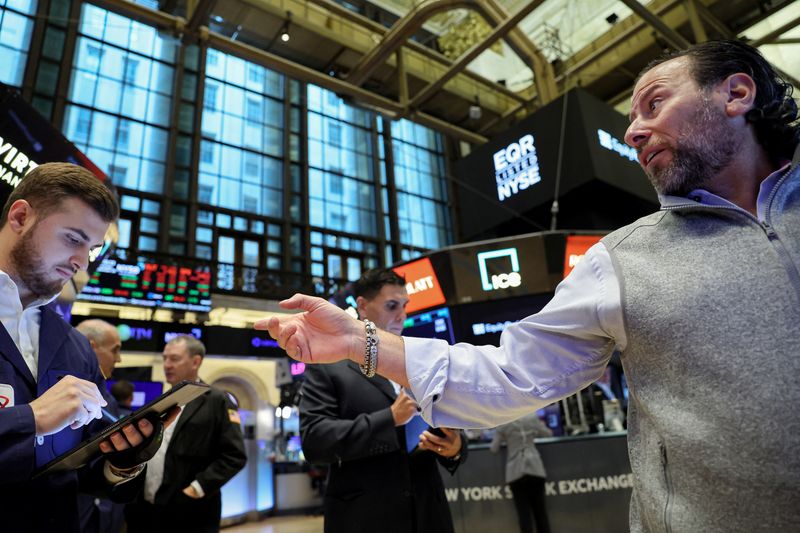By Shashwat Chauhan and Shristi Achar A
(Reuters) -The S&P 500 and the Nasdaq rose on Friday after a softer-than-expected reading on a crucial inflation metric kept alive hopes of a pause in the Federal Reserve's rate hikes, though all three main Wall Street indexes were on track for quarterly declines.
A Commerce Department report showed the personal consumption expenditures (PCE) price index, considered to be the Fed's preferred inflation gauge, climbed 0.4% in August month-on-month, against estimates of a 0.5% rise.
Excluding volatile food and energy components, the core PCE price index rose 0.1% in August month-on-month, compared with estimates of 0.2% advance.
"The data shows that we continue to see more steady progress on core inflation," said David Russell, global head of market strategy at TradeStation.
"It's not (at) 2% but still a big improvement versus where it was. That really keeps a lid on yields overall."
Traders' bets on the benchmark rate remaining unchanged in November and December stood at 85% and 67%, respectively, according to CME's FedWatch tool.
The yield on two-year and 10-year Treasury notes declined, leading growth stocks including Apple (NASDAQ:AAPL), Microsoft (NASDAQ:MSFT), Tesla (NASDAQ:TSLA), Alphabet (NASDAQ:GOOGL), Amazon.com (NASDAQ:AMZN) and Nvidia to advance between 0.7% and 2.3%.
A final reading of the September University of Michigan Consumer Sentiment Index came in at 68.1, versus expectations of 67.7.
Consumer discretionary led gains among the major S&P 500 sectors, rising 0.9%.
Energy was, however, a drag, down 1.9%. But the sector is set to emerge as the only major S&P 500 sector to notch monthly gains.
Meanwhile, the rate-sensitive real estate sector was on track to be the worst hit.
At 11:55 a.m. ET, the Dow Jones Industrial Average was down 66.49 points, or 0.20%, at 33,599.85, the S&P 500 was up 4.75 points, or 0.11%, at 4,304.45, and the Nasdaq Composite was up 72.08 points, or 0.55%, at 13,273.36.
The S&P 500 and the Nasdaq are poised for their worst monthly showing of the year amid uncertainty around interest rates. All the three indexes, including the Dow, are set for their first quarterly decline in 2023.
Fueling market volatility concerns, investors gauged the prospects of averting a government shutdown as the Democratic-led Senate forged ahead on Thursday with a bipartisan stopgap, while the House began voting on partisan Republican spending bills.
Traders would also lookout for JPMorgan (NYSE:JPM) Hedged Equity Fundas a potential source of additional volatility, as the $16 billion fund is expected to reset its options positions on Friday.
Among individual stocks, Nike (NYSE:NKE) jumped 6.0% after the sportswear maker posted a better-than-expected first-quarter profit.
Shares of sporting goods retailers Foot Locker (NYSE:FL) and Dick's Sporting Goods added 2.7% and 1.6%, respectively.
Carnival (NYSE:CCL) reversed early gains to drop 4.5% after the cruise operator's lingering cost pressures outweighed its upbeat forecast.

Advancing issues outnumbered decliners by a 1.74-to-1 ratio on the NYSE and by a 1.54-to-1 ratio on the Nasdaq.
The S&P index recorded one new 52-week high and five new lows, while the Nasdaq recorded 25 new highs and 109 new lows.